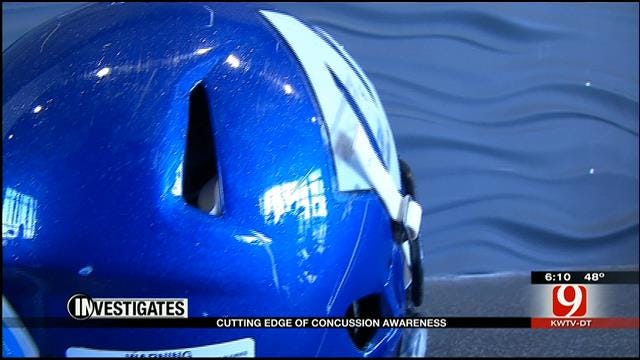Oklahoma Community At The Center Of Cutting-Edge Concussion Tech
In a recent survey, NFL players were asked: if they had a concussion, and their team was in the Super Bowl, what would they do? Eighty-five percent of the players said they would play anyway.Thursday, January 30th 2014, 7:02 pm
In a recent survey, NFL players were asked: if they had a concussion, and their team was in the Super Bowl, what would they do? Eighty-five percent of the players said they would play anyway.
That attitude, as understandable as it may be to many sports fans, reflects what many believe is still a lagging awareness of the seriousness of concussions, and especially the danger posed by not letting the concussed brain heal adequately.
One Oklahoma community has become keenly aware of the risks and, in fact, is on the cutting edge of efforts to change awareness and reduce the likelihood of a football player suffering a traumatic brain injury.
"It was on a kickoff and he was running straight ahead," said Kerali Davis.
Davis recalls the play, more than three years ago, when her son, then playing on the Newcastle middle school football team, ran headlong into a player from the other team.
"They both had their eyes straight ahead, and they just collided," Davis recounted.
She remembers the hit like it was yesterday, but says her understanding of concussions -- like the one her son suffered that night -- is now light years advanced.
"Being from Oklahoma and being around football all the time, I hadn't heard anything about concussions being a big deal," Davis allowed. "Then, as I started doing research, I realized this is kind of serious business."
Davis's research and activism led to connections with an organization called Mom's Team, which in turn led to Newcastle being asked to be part of the group's documentary on reducing concussions: The Smartest Team: Making High School Football Safer.
Participating in the documentary meant the school district would have to outfit the school's football helmets with impact sensors.
"This is the Safe Brain device," explained athletic director Dale Berglan, demonstrating how the sensor attaches inconspicuously to the back of the helmet.
For both the 2012 and 2013 seasons, Berglan says they have been able to put a sensor on the helmet of each player, at no cost to the district.
"And what it simply does it gives us an indicator that they've had some severe impacts," Beglan explained.
The devices -- there are four different types the school has used -- utilize Bluetooth technology to send an alert when it registers a strong enough impact. Some of the sensors -- those that mount on the outside -- also light up.
With some head impacts, coaches and trainers don't need a sensor to let them know they need to check a player for signs of concussion.
But many impacts aren't as obvious, and Berglan says the sensors make sure they don't miss anything. That way, all players who sustain head impacts are properly evaluated, and, if necessary, removed from the field.
"I think the most important thing is being able to give further protection to the athletes," Berglan stated.
Extra protection, it would seem, is needed. According to statistics compiled by Mom's Team, concussions among high school athletes doubled between 1998 and 2008, with football players sustaining by far the most -- 30 percent.
"We don't know yet how valuable it is," said OU neurosurgeon, Dr. Craig Rabb about the research being done with helmet sensors. "I think it certainly is going to provide data, at a bare minimum, to try to help understand what thresholds of force may be associated with concussions."
Rabb says the danger with concussion victims is that they return to play before the brain has healed and sustain a second hit. Helmet sensors can't prevent the first hit, but they can prevent the second.
"Probably more players are gonna be held out, as a precautionary measure," said Rabb. "And, ya know, coaches may not like that, but I think safety, again, is of utmost importance."
Kerali Davis couldn't agree more.
"If you can identify the first hit, and pull someone out and let them recover. Then you're preventing a death, perhaps, from happening," Davis said.
Newcastle will continue using the sensors and they encourage other school districts to do the same, even though they would have to pay for them.
Only 20 percent of Oklahoma high schools have certified athletic trainers, so, the thinking is, the extra help, in the form of helmet sensors, might well be worth the cost.
More Like This
January 30th, 2014
June 28th, 2024
Top Headlines
July 26th, 2024
July 26th, 2024













